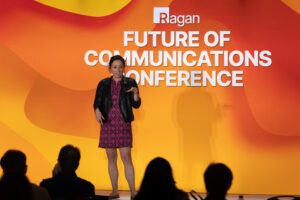Conferences: The jelly to the peanut butter of media relations
They just go together.

Tara Baumgarten is head of public relations and strategic communications for //NKST.
Traditionally, businesses have relied on public relations, specifically media relations, as their primary channels for building their brand story and executive visibility. However, there’s an often-overlooked cornerstone: conferences.
Conferences serve as vital building blocks in an integrated communications strategy because of their ability to foster thought leadership, nurture relationships through networking and spur ideas.
In short, if conferences are not part of your communications mix. They should be. Here’s why.
Why conferences matter
For decades, media relations have been the bedrock of PR, and for good reason. When stories are placed in reputable and relevant publications, they carry a third-party endorsement that can’t be denied. It provides a company or thought leader credibility and validation, bolstering reputations, building trust and making them a more obvious choice to do business with.
While media coverage remains valuable for brand visibility and credibility, it is an indirect channel. Conversely, through face-to-face interactions, conferences promote the exchange of ideas and the building of meaningful relationships. They offer a distinct advantage that sets them apart from traditional media relations in a few ways.
- The timeline. While media relations are all about the here and now, conferences play the long game. Media relations allow brands and thought leaders to respond to breaking news, address a trending issue and be part of the commentary. Whereas conferences provide a longer-term platform for relationship building, brand exposure, and executive visibility. That longer timeline allows brands to be more strategic about their presence at an event and the marketing they do in support of an executive’s appearance. The longer timeline also provides a built-in cushion to plan for major announcements, the unveiling of new research or survey results, or the launch of a book, product or service.
- The feedback. Media placements can provide a clue to customer and stakeholder interest through measures like website traffic, engagement with the article or podcast and reactions/shares on social posts, but that information is limited. Conferences are like a live chat session with your audience. Unlike the media, which can sometimes feel one-sided, with conferences, you’re in the thick of it, mingling with attendees and fellow speakers, swapping stories and getting instant feedback and insights into audience reactions, preferences, concerns or questions. It’s like having a real-time focus group at your fingertips. These insights can enhance a company or thought leader’s understanding of their target audiences and ultimately strengthen their connection with their market.
- The gatekeepers. The importance of building genuine relationships with conference organizers cannot be overstated. With media, relationship building is the golden rule, too, but with the media there can be dozens of targets at one publication whereas with conferences, there is generally one gatekeeper or a very small team responsible for programming content. They hold the keys to the kingdom and building that relationship is key.
But here’s the catch: This cannot be a one-sided relationship. PR and communications pros need to understand that just like with media, we work for the conference organizer, not the other way around. This includes taking the time to understand their needs, which differ from platform to platform, the demands on them to put butts in seats and how that translates to the content, themes, and the speakers they look for, and their goals for each particular event. It is only after you have taken the time to develop this relationship and understand their needs that you will be recognized, and hopefully relied upon as a valuable go-to resource. Like with media relationships, the goal should always be to develop a trusted relationship that has conference organizers tapping into you for ideas and recommendations, and not the other way around.
Media and conference relations: Like peanut butter and jelly.
While landing a coveted speaking role at a conference is important, securing the speaking opportunity is just the beginning. It is how you leverage that opportunity that matters. Though conferences offer an added and distinct benefit from media, the magic happens when the two disciplines are combined for maximum impact.
For example, say your executive is scheduled for a fireside chat at a major industry conference. Key takeaways from their speech can be adapted into a byline article that is published in coordination with their presentation. Next, event footage can be leveraged for a series of vignettes on social media and corporate blogs. And, taking it one step further, content from the event can be adapted for a customized drip campaign for prospects and as a client building exercise with existing clients. These combined steps fill your marketing and sales content pipeline, reinforce important messages, and cement those concepts with your organization and its leaders.
This added layer of publicity extends the reach of the event, boosting both the company and executive’s credibility with clients, prospects, partners and investors, driving business growth.
In today’s competitive business landscape, where customer loyalty reigns supreme, connecting with stakeholders is a multi-touchpoint brand imperative. Combining the benefits of media and conference relations is not just beneficial, it is essential for marketing and business impact, and sustained growth.
The future of marketing is integrated – ensure your strategy is, too.






